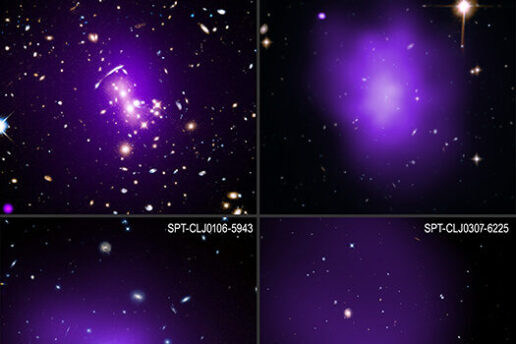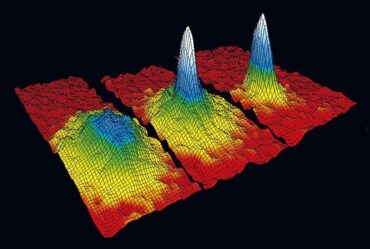
Astronomers Find Spark of Star Birth Across Billions of Years
Astronomers have completed the largest and most detailed study of what triggers stars to form in the universe’s biggest galaxies, using NASA’s Chandra X-ray Observatory and other telescopes. They were surprised to find that the conditions for stellar conception in these exceptionally massive galaxies have not changed over the last ten billion years.
“What’s surprising here is that there are lots of things that could have affected star formation over the last ten billion years,” said Michael Calzadilla of the Massachusetts Institute of Technology (MIT) who led the study. “In the end, however, the main driver of star formation in these huge galaxies really comes down to one thing – whether or not the hot gas surrounding them can cool off quickly enough.”
Clusters of galaxies are the largest objects in the universe held together by gravity and contain huge amounts of hot gas seen in X-rays. The mass of this hot gas is several times the total mass of all the stars in all the hundreds of galaxies typically found in galaxy clusters.
Calzadilla and his colleagues studied the brightest and most massive class of galaxies in the universe, called brightest cluster galaxies, in the centers of 95 clusters of galaxies. The galaxy clusters chosen are themselves an extreme sample — the most massive clusters in a large survey using the South Pole Telescope (SPT) with funding support from the U.S. National Science Foundation and Department of Energy — and are located between 3.4 and 9.9 billion light-years from Earth.
The team found that star formation in the galaxies they studied is triggered when the amount of disordered motion in the hot gas — a physical concept called “entropy” — falls below a critical threshold. Below this threshold, the hot gas inevitably cools to form new stars.
“It’s impressive to think that a single number tells us whether billions of stars and planets formed in these huge galaxies, going back ten billion years,” said co-author Michael McDonald, also of MIT.
While other attempts have been made to identify the drivers of star formation in such huge galaxies over cosmic time, this survey is the first to combine X-ray and optical observations of the centers of clusters over such a large range of distances. This allows the researchers to connect the fuel required for stars to form — the hot gas detected with Chandra — to the actual formation of stars after the gas cools, as seen with optical telescopes, over most of the history of the universe.
The team also used radio telescopes to study jets of material firing away from supermassive black holes in these clusters. In a process called “feedback,” the hot gas that cools to form stars eventually feeds the black holes, resulting in jets and other activity that heats and energizes their surroundings, temporarily preventing further cooling. When the black hole runs out of fuel, the jets turn off and the process starts again.
“It’s as if we’ve collected different chapters for the book of star formation across most of the universe’s lifetime,” said co-author Brad Benson, from the University of Chicago and Fermilab in Illinois. “Instead of being written in words, this story is told in X-ray, optical, and radio light.”
An unexpected aspect of this study is that previous works had suggested that other factors besides the cooling of hot gas might play a bigger role in star formation in the distant past. Ten billion years ago, in a period astronomers call “cosmic noon,” collisions and mergers of galaxies in clusters were much more common, the rates of star formation were generally much higher and the galaxy’s supermassive black holes were pulling in material much more quickly.
“The type of star formation we’re seeing is remarkably consistent, even approaching cosmic noon when it could have been overwhelmed by other processes,” said co-author Lindsey Bleem of Argonne National Laboratory in Illinois. “Although the universe looked very different back then, the trigger for stars to form in these galaxies does not.”
In studying relatively nearby clusters, previous researchers have also found a threshold level of disorder in the hot gas is required for feedback from supermassive black holes, in the form of jets, to occur. This new study by Calzadilla’s team found that the entropy threshold for feedback, however, does not apply to galaxies in more distant clusters, which could mean that clusters about ten billion years ago are not as well regulated by black hole feedback. This is plausible because it takes time for the hot gas to begin cooling down onto the central galaxy, and then more time for that cool gas to make its way to the central galaxy’s supermassive black hole and then, finally, for jets to form and prevent further cooling of gas. It is also possible, however, that radio signals do not give a clear indication of jet activity at these early times.
This result is based on X-ray data from NASA’s Chandra X-ray Observatory; radio data from the SPT, the Australia Telescope Compact Array, and the Australian SKA Pathfinder Telescope; infrared data from NASA’s WISE satellite; and several optical telescopes. The optical telescopes used here are the Magellan 6.5-m Telescopes, the Gemini South Telescope, the Blanco 4-m Telescope (DECam, MOSAIC-II), and the Swope 1m Telescope. A total of almost 50 days of Chandra observing time was used for this result.
Caldazilla presented these results at the 243rd meeting of the American Astronomical Society in New Orleans. In addition, he is the first author of a paper submitted to The Astrophysical Journal on this work (preprint here). NASA’s Marshall Space Flight Center manages the Chandra program. The Smithsonian Astrophysical Observatory’s Chandra X-ray Center controls science operations from Cambridge, Massachusetts, and flight operations from Burlington, Massachusetts.


